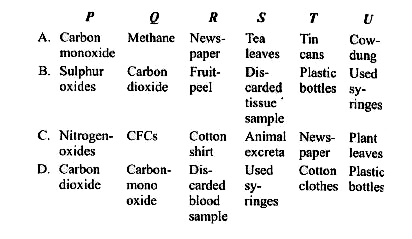Refer to the given dichotomous key.
I. (a) It is a solid waste. - Go to II
(b) It is a gaseous waste. - Go to III
II. (a) It is biodegradable. - Go to IV
(b) It is non-biodegradable. - Go to V
III. (a) It causes acid rain.-P
(b) It leads to global warming.-Q
IV. (a) It can be composted.-R
(b) It cannot be composted. - S
V. (a) It can be recycled. - T .
(b) It cannot be recycled.-U
Select the option that correctly identifies P, Q, R, S, T and U.

The correct Answer is:B
Sulphur oxides and carbon dioxide are gaseous wastes that cause acid rain and global warming respectively. Fruit peel is biodegradable and can be composted. Discarded tissue sample is biodegradable and cannot be composted. Plastic bottles are non-biodegradable and can be recycled. Used syringes are non-biodegradable but cannot be recycled.
Topper's Solved these Questions
- NSO QUESTION PAPER 2017-18 SET BBook:SCIENCE OLYMPIAD FOUNDATION Chapter:NSO QUESTION PAPER 2017-18 SET BExercise:ACHIEVERS SECTION
Explore 2 Videos
- NSO QUESTION PAPER 2017-18 SET ABook:SCIENCE OLYMPIAD FOUNDATION Chapter:NSO QUESTION PAPER 2017-18 SET AExercise:ACHIEVERS SECTION
Explore 3 Videos
- NSO QUESTION PAPER 2018-19 SET ABook:SCIENCE OLYMPIAD FOUNDATION Chapter:NSO QUESTION PAPER 2018-19 SET AExercise:ACHIEVERS SECTION
Explore 2 Videos
Similar Questions
Knowledge Check
Refer to the given dichotomous key. Identi fy P -T and select the incorrect statement.
I. (a) It is unicellular organism. - Go to II
(b) It is multicellular organism. Go to IV
II. (a) It possesses well organised nucleus. Go to III
(b) It lacks well organised nucleus. -P
III. (a) Nutrition is parasitic. -Q
(b) Nutrition is mixotrophic. -R
IV. (a) It possesses chlorophyll. - S
(b) It lacks chlorophyll. -TAP can convert lactose sugar of milk into lactic acid.BR could be Euglenaa which possesses cilia that helps in movement.CQ could be Plasmodium which causes malaria or it could be Entamoeba which causes amoebic dysentery in humans.DS could be a plant like pondweed whereas T could be a scavenger like vulture or a decomposer like Rhizopus.Refer to the given dichotomous key. Identi fy P -T and select the incorrect statement.
I. (a) It is unicellular organism. - Go to II
(b) It is multicellular organism. Go to IV
II. (a) It possesses well organised nucleus. Go to III
(b) It lacks well organised nucleus. -P
III. (a) Nutrition is parasitic. -Q
(b) Nutrition is mixotrophic. -R
IV. (a) It possesses chlorophyll. - S
(b) It lacks chlorophyll. -TAP can convert lactose sugar of milk into lactic acid.BR could be Euglena which possesses cilia that helps in movement.CQ could be Plasmodium which causes malaria or it could be Entamoeba which causes amoebic dysentery in humans.DS could be a plant like pondweed whereas T could be a scavenger like vulture or a decomposer like Rhizopus.One of the best solutions to get rid of non-biodegradable waste is
ABurningBDumpingCBuryingDRecycling
Explain the phenomena of : (a) Acid rain, (b) Global warming
View SolutionWastes:Biodegradable || Non-biodegradable
View SolutionRefer to the given dichotomous key and answer the following questions.
I. (a) The cells of tissue have walls. - Go to II
(b) The cells of tissue do not possess wall. - Go to III
II. (a) Tissue made of one type of cells. - Go to IV
(b) Tissue, made of more than one type of cells. - Go to V
III. (a) The tissue lines the alveoli of lungs. -P
(b) The tissue forms shock absorbing cushion around some vital organs. - Q
IV. (a) Cells of tissue contain air cavities and it provides buoyancy. -R
(b) The tissue provides mechanical strength and flexibility to young dicot stems and petioles. - S
V. (a) Tissue conducts water. - T
(b) Tissue conducts organic solutes. - U
Select the incorrect option regarding tissues P, Q, R, S, T and U.
View SolutionA tissue made up of only one type of differentiated cells is
View SolutionRead the following statements.
A. Nerve cells do not have the ability of regeneration.
B. Nerve cells are one kind of muscle tissue.
C. No two nerve cells have same appearance.
D. Nervous tissue is a fluid tissue.
Which of the following is true?
View Solution